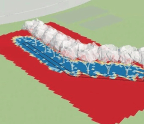Jury comment
This year, the jury was pleased to see such a wide breadth of issues being addressed across the spectrum of winners in this edition – from a design for the repatriation of Indigenous ancestral remains to a masterplan that encourages a more equal relationship between human and non-human species.
From within this pool, the jury is pleased to announce joint winners of this year’s Landscape Student Prize: Vanishing Landscape by Jialin (Mazarine) Wu of RMIT University and Drawing landscape narrative: Interfacing between the cultural, ecological and habitation imperatives of Tallow Creek ICOLL watershed by Nathan Galluzzo of University of Technology Sydney.
deserves recognition for tackling a challenging issue of major significance to landscape architecture practice. The project presents a clear and contextual project that evidences a genuine passion for the subject matter, demonstrates critical and reflective thinking and presents a strong sense of what has been learnt through the process and how this might be further continued and explored. Of particular note is the project’s restraint and focus.




